RARE ANTIQUE c. 18th CENTURY LARGE 2 1/8 ORTHODOX OLD BELIEVERS CROSS PSALM 68

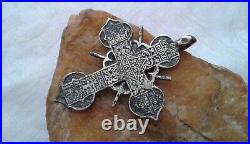

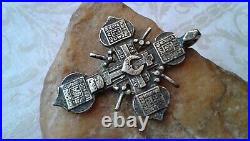
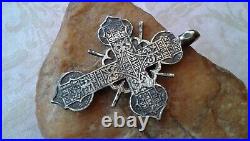

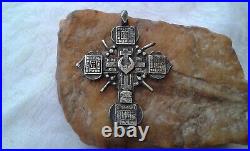
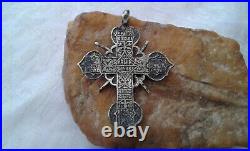
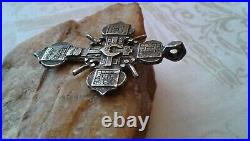
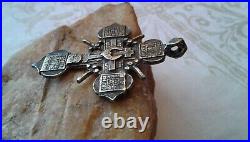
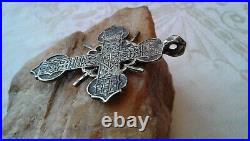
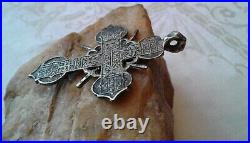
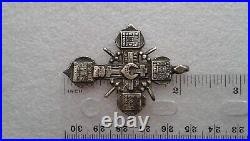
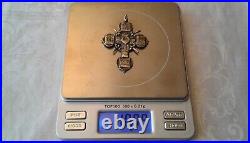
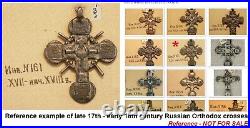

2 1/8 tall with solid bale; weight approx. 10 g Orthodox Cross pendant featuring an 18th century Russian "Old Believers". Ornate openwork design with the center of the Cross surrounded by ornamental circle similar to a "Solar", or a "Sun" cross and rich symbolism of images, ornaments and texts inscribed on both sides in Church Slavonic.
The obverse bears an image of the three-bar Savior's Cross with the crescent-shaped "Tsata", an ancient Byzantine symbol of Christ as both the King and High Priest, flanked with the Instruments of the Passion standing above the skull (Adam's head), and words of the Troparion (Orthodox hymn) to the Holy Cross, whereas the reverse displays the Orthodox prayer to the Holy Cross based on Psalm 68 of David the King. Whoever follows me will never walk in darkness (John 8:12). The Cross appears to have been hand made from a historical copper alloy of unknown composition. It shows distinct marks from grinding file tools of the coppersmith maker.
Origin likely circa late 17th - 18th century Russia (according to available catalogs describing similar findings; please see the last picture for a reference). The item shows significant signs of wear due to its old age and long devotional wearing, such as reduced quality of artwork, visible deformations of the original shape, scratches or. Dents and patches of patina/oxidation. Most of the original thick patina has been removed using a complex procedure of cleaning and polishing. Some pictures taken under bright illumination could give an impression that the metal is silvery.
But its real color shows some yellow (brass-like) tone reflecting presence of copper in the metal alloy. The size and weight of the Cross are shown on the photographs for this listing. The obverse displays an image of the three-bar Suppedaneum cross which is venerated as the true Savior's Cross in the Slavonic Orthodox and some Eastern Catholic churches. Such a cross has three horizontal crossbeams: the top one represents the "INRI" nameplate, and the bottom one, a footrest.
The footrest bar is depicted pointing up, toward Heaven, on Christ's right hand side where the Penitent thief, St. The Cross bears the "Tsata", a symbol that could be described as a neck decoration shaped as a turned over crescent, which was used for the Holy Trinity or Jesus to signify the highest status in the Kingdom of God. The Savior's Cross is marked with abbreviated inscriptions in Church Slavonic incorporated into four "boxes" positioned in each of the four crossbar ends. The top "boxed" end of the vertical crossbar has a Church Slavonic monogram "? C" meaning "King of Glory". The "boxed" left and right side ends of the central horizontal crossbar of the pendant bear the Sacred Name of Jesus Christ inscribed as the "IC XC" Greek Christogram, the "IC" on the left, and the "XC" on the right. The bottom "boxed" end of the vertical crossbar shows. " ("MLRB") abbreviation meaning "The CALVARY (Golgotha) BECAME PARADISE", a symbol of the execution place becoming a place of the redemption and reclaiming of the lost paradise. These monograms are framed with smaller Church Slavonic words of the Troparion (Orthodox hymn) to the Holy Cross beginning with???????????? " in the top box ("Before Thy Holy Cross we bow down in worship, o Lord, and Thy Holy Resurrection we glorify).Parallel to the vertical crossbar, there are images of the two Instruments of the Passion which a. Re subjects to adoration along with the Cross. Of a Roman soldier is. Kopiye" in the space just below the horizontal crossbar of the Savior's Cross, whereas the Holy Sponge attached to the end of a cane is marked as "TP" for the Church Slavonic ". A symbolic image of the skull, or Adam's head, buried below the Savior's Cross refers to Golgotha (Calvary), the elevated site where Jesus was crucified, which the Bible says means "the place of the skull" in Hebrew.
An ancient tradition of the Church held that it was also the burial place of Adam, thus symbolizing the ultimate victory of Christ over sin and death. There are four additional, diagonal crossbeams superimposed on the circle surrounding the center of the cross. The diagonal crossbeams usually refer to the cross of Saint Andrew the Apostle. Alternatively, they could symbolize the rays of light. Andrew is considered the Founder and the first Bishop of the Christian Church of Byzantium, and is the patron saint of the Ecumenical Patriarchate of Constantinople.Saint Andrew is believed to have been crucified on the Crux decussata (X-shaped cross, also known as "Saltire"). The reverse shows a fragment of the prayer to the Holy Cross based on Psalm 68 beginning with????????????????????????????????? " meaning "MAY GOD ARISE AND MAY HIS ENEMIES BE SCATTERED.
This psalm-based prayer is traditionally inscribed on the reverse of the Old Believers' Orthodox body (Baptism) cross pendants, meaning to provide protection of the faithful cross-bearer against the evil spirits (God's enemies), and thereby is considered a version of the Exorcism prayer. The text is incorporated into. Please examine all photographs carefully and do your own research if necessary. Please note that photographs are an important part of the item's description. The decorative stone and measuring meter are not for sale, and are photographed with the item in order to provide a size reference.There are no guarantees with the listing because most items are original vintage or antique objects that are quite old.
